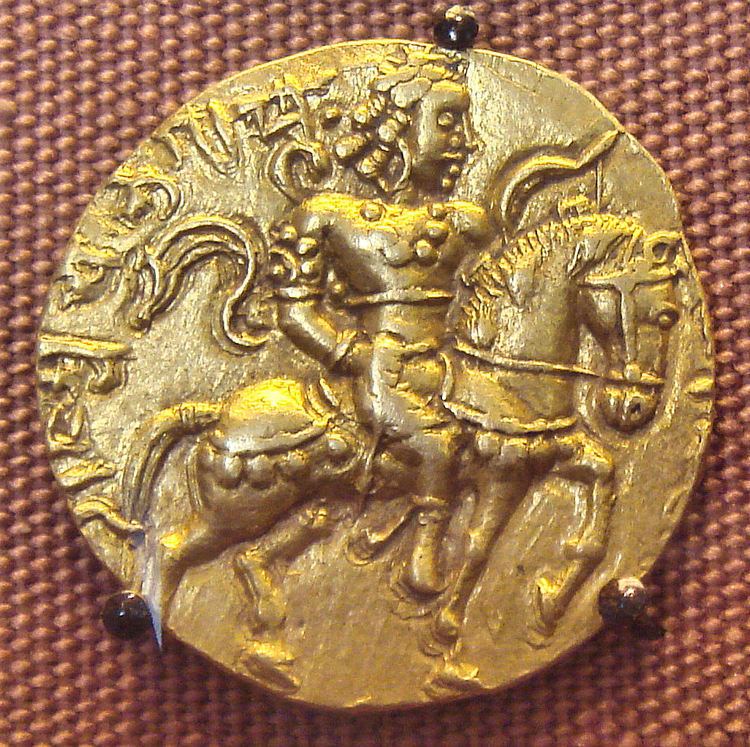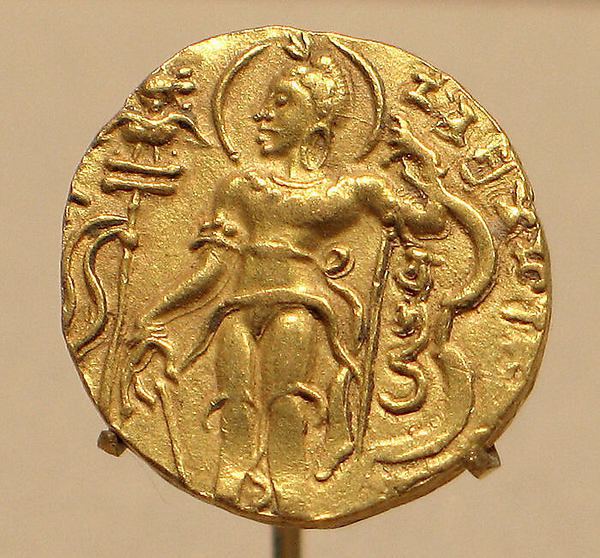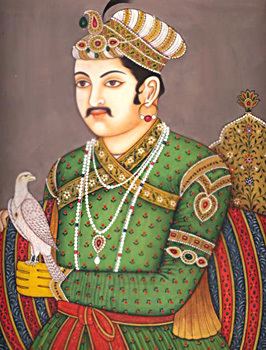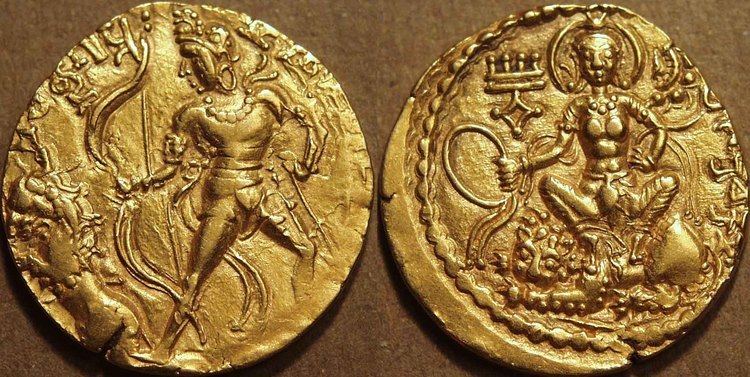Reign c. 375 – c. 415 CE Issue Template:Flatist Wives DhruvadeviKuberanaga | Name Chandragupta II | |
 | ||
Similar People | ||
INDIAN HISTORY - Great Emperors of Indian History - Samudragupta and Chandragupta II
Chandragupta II (also known as Chandragupta Vikramaditya) was one of the most powerful emperors of the Gupta Empire in India. His rule spanned c. 380 – c. 415 CE during which the Gupta Empire reached its peak. Art, architecture, and sculpture flourished, and the cultural development of ancient India achieved new heights. The period of prominence of the Gupta dynasty is often referred to as the "Golden Age" of India. Chandragupta II was the son of the previous ruler, Samudragupta. He attained success by pursuing both a favourable marital alliance and an aggressive expansionist policy in which his father and grandfather (Chandragupta I) set the precedent. Samudragupta set the stage for the emergence of classical art, which occurred under the rule of Chandragupta II. Chandragupta II extended great support to the arts.
Contents
- INDIAN HISTORY Great Emperors of Indian History Samudragupta and Chandragupta II
- GUPTA EMPIRE CHANDRAGUPTA II VIKRAMADITYA P 4
- Early life
- Military victories
- Visit of Faxian
- Religion
- Coinage
- Iron pillar of Delhi
- Identification with the legendary Vikramaditya
- Vikram Samvat
- Navaratnas
- References

From 388 to 409 he subjugated Gujarat, the region north of Mumbai, Saurashtra, in western India, and Malwa, with its capital at Ujjain.

GUPTA EMPIRE(गुप्त साम्राज्य)- CHANDRAGUPTA II (VIKRAMADITYA) चंद्रगुप्त (विक्रमादित्य) | P-4 |
Early life

Chandragupta II's mother, Datta Devi, was the chief queen of Samudragupta.

Dhruvadevi was Chandragupta II's chief queen, as seen in the Vaisali Terracotta Seal that calls her "Mahadevi" (Chief Queen) Dhruvasvamini. The Bilsad Pillar Inscription of their son Kumaragupta I (r. 414–455 CE) also refers to her as "Mahadevi Dhruvadevi". The fragment from Vishakhadatta's play "Natya-darpana" mentions that Ramagupta, the elder brother of Chandragupta II, decided to surrender Dhruvadevi to the Saka ruler Rudrasimha III of the Western Kshatrapas dynasty, when faced with a military defeat. Chandragupta himself went to Rudrasimha III disguised as the queen, and then assassinated the enemy rulers. According to D. C. Sircar, the only facts in this story are that Dhruvadevi was Chandragupta's queen and the Saka ruler Rudrasimha III held power in western India. Everything else is "Vishakhadatta's own imagination or some current popular legends embellished by his imagination".

The Allahabad Pillar inscription mentions the marriage of Chandragupta II with a Naga princess Kuberanaga. A pillar from Mathura referring to Chandragupta II has recently been dated to 388 CE.
Chandragupta II's daughter, Prabhavatigupta, by his Naga queen Kuberanaga was married to the powerful Vakataka dynasty ruler Rudrasena II (r.380–385 CE). His son-in-law died in 385 CE after a very short reign, following which Queen Prabhavatigupta (r. 385–405) ruled the Vakataka kingdom as a regent on behalf of her two sons. During this twenty-year period, the Vakataka realm was practically a part of the Gupta empire.
Military victories
Chandragupta is believed to have defeated the Western Kshatrapas led by Rudrasimha III, capturing Malwa and Gujarat in the process. The geographical location of the Vakataka kingdom allowed Chandragupta II to take the opportunity to defeat the Western Kshatrapas once for all. Many historians refer to this period as the Vakataka-Gupta Age.
Chandragupta II controlled a vast empire, from the mouth of the Ganges to the mouth of the Indus River and from what is now North Pakistan down to the mouth of the Narmada. Pataliputra continued to be the capital of his huge empire but Ujjain too became a sort of second capital. The large number of beautiful gold coins issued by the Gupta dynasty are a testament to the grandeur of that age. Chandragupta II also started producing silver coins in the Western Satrap tradition in his western territories.
Chandragupta II was succeeded by his second son Kumaragupta I, born of Mahadevi Dhruvasvamini.
Visit of Faxian
Faxian (c. 337 – c. 422) was the first of the three notable Buddhist pilgrims from China who visited India from the fifth to the seventh centuries CE in search of knowledge, manuscripts, and relics. Faxian arrived during the reign of Chandragupta II. While he did not mention Chandragupta Vikramaditya by name in his travelogue, he provided a general description of North India at that time. Among other things, he reported about the absence of capital punishment, the lack of a poll-tax and land tax. Most citizens did not consume onions, garlic, meat, and wine.
Faxian wrote, "The people were rich and prosperous and seemed to emulate each other in the practice of virtue. Charitable institutions were numerous and rest houses for travelers were provided on the highway. The capital possessed an excellent hospital."
Religion
From Chandragupta II kings of Gupta dynasty are known as Parama Bhagavatas or Bhagavata Vaishnavas. The Bhagavata Purana entails the fully developed tenets and philosophy of the Bhagavata tradition wherein Krishna gets fused with Vasudeva and transcends Vedic Vishnu and cosmic Hari to be turned into the ultimate object of bhakti.
Coinage
Chandragupta continued issuing most of the gold coin types introduced by his father Samudragupta, such as the Sceptre type (rare for Chandragupta II), the Archer type, and the Tiger-Slayer type. However, Chandragupta II also introduced several new types, such as the Horseman type and the Lion-slayer type, both of which were used by his son Kumaragupta I.
In addition, Chandragupta II was the first Gupta king to issue silver coins, such as the one illustrated at right. These coins were intended to replace the silver coinage of the Western Kshatrapas after Chandragupta II defeated them, and were modelled on the Kshatrapa coinage. The main difference was to replace the dynastic symbol of the Kshatrapas (the three-arched hill) by the dynastic symbol of the Guptas (the mythic eagle Garuda). Further, Chandragupta also issued lead coins based on Kshatrapa prototypes and rare copper coins probably inspired by the coins of another tribe he defeated, the Nagas.
Iron pillar of Delhi
Close to the Qutub Minar is one of Delhi's most curious structures, an iron pillar, dating back to 4th century CE. The pillar bears an inscription which states that it was erected as a flagstaff in honour of the Hindu god Vishnu, and in the memory of Chandragupta II (A derivation of "Natya-darpana" by Vishakadata states that the pillar had been put up by Chandragupta II himself after defeating Vahilakas. And after this great feat, he put up this pillar as a memory of the victory). The pillar also highlights ancient India's achievements in metallurgy. The pillar is made of 98% wrought iron and has stood more than 1,600 years without rusting or decomposing.
Identification with the legendary Vikramaditya
Vikramaditya is a legendary emperor of ancient India, who is characterised as the ideal king, known for his generosity, courage, and patronage to scholars. A number of historians believe that at least some of the Vikramaditya legends are based on Chandragupta II. These historians include D. R. Bhandarkar, V. V. Mirashi and D. C. Sircar among others.
Based on some coins and the Supia pillar inscription, it is believed that Chandragupta II adopted the title "Vikramaditya". The Khambat and Sangli plates of the Rashtrakuta king Govinda IV use the epithet "Sahasanka" for Chandragupta II. The name "Sahasanka" has also been applied to the legendary Vikramaditya.
The legendary Vikramaditya is said to have defeated the Śaka invaders, and was therefore, known as Śakari ("enemy of the Śakas). Chandragupta II conquered Malwa after defeating the Western Kshatrapas (a branch of Śakas); he also expelled the Kushanas from Mathura. His victory over these foreign tribes was probably transposed on upon a fictional character, resulting in the Vikramaditya legends.
According to most legends, Vikramaditya had his capital at Ujjain, although some legends mention him as the king of Pataliputra. The Guptas had their capital at Pataliputra. According to D. C. Sircar, Chandragupta II may have defeated the Shaka invaders of Ujjain, and placed his son Govindagupta as a viceroy there. As a result, Ujjain might have become a second capital of the Gupta empire, and subsequently, legends about him (as Vikramaditya) might have developed. Guttas of Guttavalal, a minor dynasty based in present-day Karnataka, claimed descent from the imperial Guptas. The Caudadanapura inscription of the Guttas alludes to the legendary Vikramaditya ruling from Ujjayni, and several Gutta royals were named "Vikramaditya". According to Vasundhara Filliozat, their reference to the legendary Vikramaditya is simply because they confused him with Chandragupta II. However, D. C. Sircar sees this as further proof that the legendary Vikramaditya was based on Chandragupta II.
Vikram Samvat
Vikrama Samvat, an Indian calendar era beginning in 57 BCE, is associated with the legendary Vikramaditya. However, this association did not exist before 9th century CE. The earlier sources call this era by various names, including Kṛṭa, the era of the Malava tribe, or simply, Samvat. Scholars such as D. C. Sircar and D. R. Bhandarkar believe that the name of the era changed to "Vikram Samvat" after the reign of Chandragupta II, who had adopted the title Vikramaditya.
Navaratnas
Jyotirvidabharana (22.10), a treatise attributed to Kalidasa, states that nine famous scholars known as the Navaratnas ("nine gems") attended the court of the legendary Vikramaditya. Besides Kalidasa himself, these included Amarasimha, Dhanvantari, Ghatakarapara, Kshapanaka, Shanku, Varahamihira, Vararuchi, and Vetala Bhatta. However, there is no historical evidence to show that these nine scholars were contemporary figures or proteges of the same king. Jyotirvidabharana is considered a literary forgery of a date later than Kalidasa by multiple scholars. There is no mention of such "Navaratnas" in earlier literature, and D. C. Sircar calls this tradition "absolutely worthless for historical purposes".
Nevertheless, multiple scholars believe that one of these Navaratnas – Kalidasa – may have indeed flourished during the reign of Chandragupta II. These scholars include William Jones, A. B. Keith, and Vasudev Vishnu Mirashi among others.
